Introduction
Only between 172,700 and 299,700 extremely endangered chimpanzees (Pan troglodytes) remain in the wild1https://www.iucnredlist.org/species/15933/129038584#population and their numbers have been plummeting since the 1800s. Although chimpanzees are widespread across Africa, their groups are shrinking and becoming more fragmented. In some places, their population has shrunk by a staggering 90 per cent in just 20 years.2https://wwf.panda.org/discover/knowledge_hub/endangered_species/great_apes/chimpanzees/
Uganda is home to approximately 5,000 common, or eastern, chimpanzees (P. t. schweinfurthii).1https://www.iucnredlist.org/species/15933/129038584#population The largest populations live in Kibale and the Rwenzori Mountains National Parks and Budongo and Bugoma Forest Reserves. They also live in Maramagambo, Kalinzu and Kasyoha-Kitomi forests, as well as 400 recorded individuals in Bwindi Impenetrable National Park.3https://www.bwindiimpenetrablenationalpark.com/see/wildlife/mammals/chimpanzees/ Bwindi National Park is the only place in the world where chimpanzees and mountain gorillas live in the same area, and means that Bwindi is home to two of the largest primates on the planet.
Fascinating facts
The chimpanzee is our closest relative
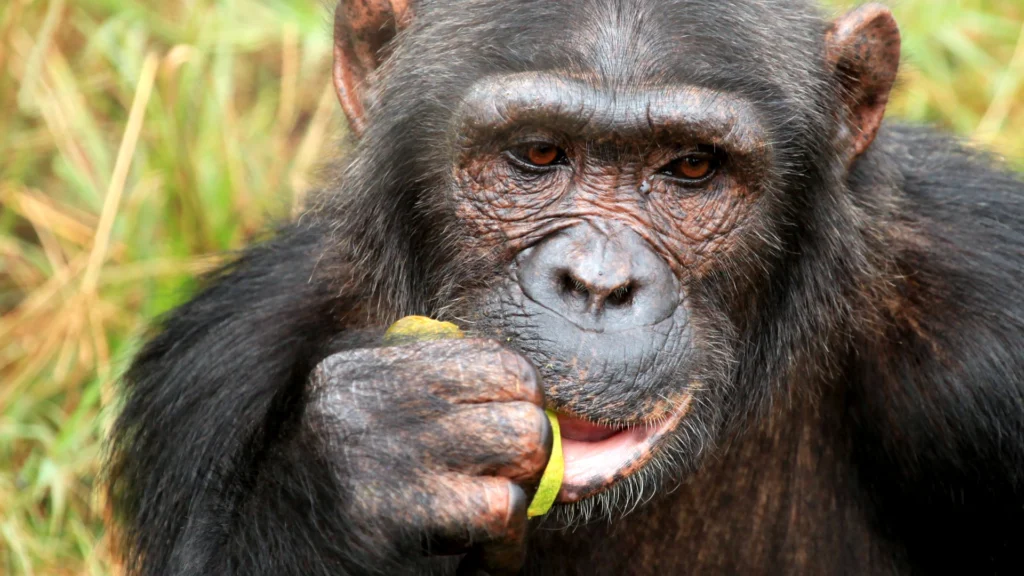
Humans and chimpanzees share 98.4 per cent of the same DNA.4https://www.wildchimps.org/about-chimpanzees/why-are-we-so-similar.html We share a common ancestor but between 6.5 million and 9.3 million years ago our ancestors separated to form two distinct species. Chimps are smaller than humans. The females typically weigh between 5 and 7.4 stone (32 to 47 kg); and the males weigh typically weigh between 6.3 and 9.4 stone (40 to 60 kg). The average chimpanzee lifespan in the wild is between 45 and 50 years, with some living as long as 60 years.5https://neprimateconservancy.org/common-chimpanzee-pan-troglodytes/
Chimps have an arm span 1.5 times longer than their height!
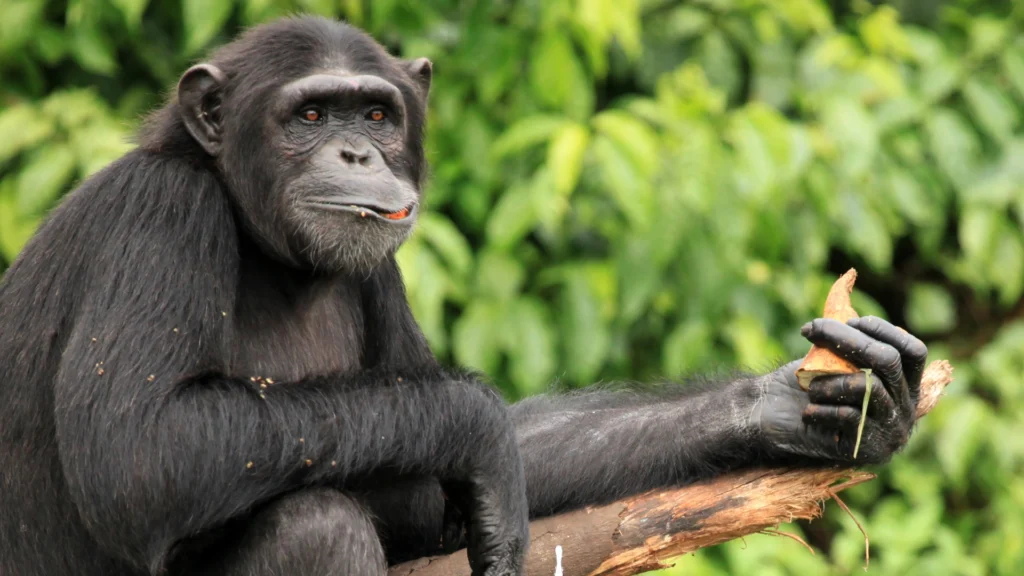
Chimps are between 4 and 5.5 feet tall (1.22 m to 1.68 m), but their arms can span 8 feet (2.4 m)!5https://neprimateconservancy.org/common-chimpanzee-pan-troglodytes/ They use their long arms to swing gracefully through the trees. They can walk upright but spend most of their time walking on their hands and feet. Like us, they have opposable thumbs which means they can manipulate small objects and grasp branches easily.
Cheeky chimpanzees!
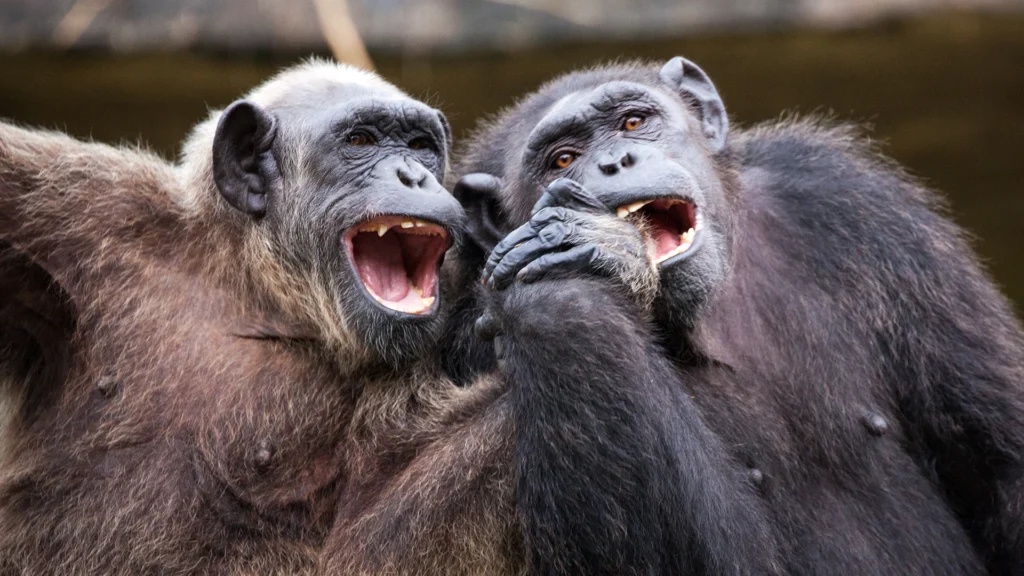
Chimps, gorillas, bonobos and orangutans all love to make a monkey out of each other! They tickle and poke each other for fun. They also steal from each other just to playfully tease. Their sense of humour shows how smart they are. They also laugh when they are tickled, or when they wrestle and play-chase.6https://www.livescience.com/60864-do-animals-have-humor.html 7https://www.newscientist.com/article/2417005-great-apes-like-teasing-each-other-which-may-be-the-origin-of-humour/ Chimpanzees can make silent ‘laugh faces’ just like humans. 8https://journals.plos.org/plosone/article?id=10.1371/journal.pone.0127337
Chimpanzees are devoted mothers

Female chimpanzees have one baby every five or six years. Pregnant chimps give birth at around eight months to a tiny baby which only weighs about four pounds (1.8 kg). The baby is totally dependent on their mother and all they can do is cling to her fur as she gently clutches them to her chest. When the infant reaches six months old, they move to their mother’s back and are carried around until two years old. The infant is weaned at five years old, and then it’s time for the mother to start the process all over again with a new baby.
Chimpanzees are 90 per cent plant-based!
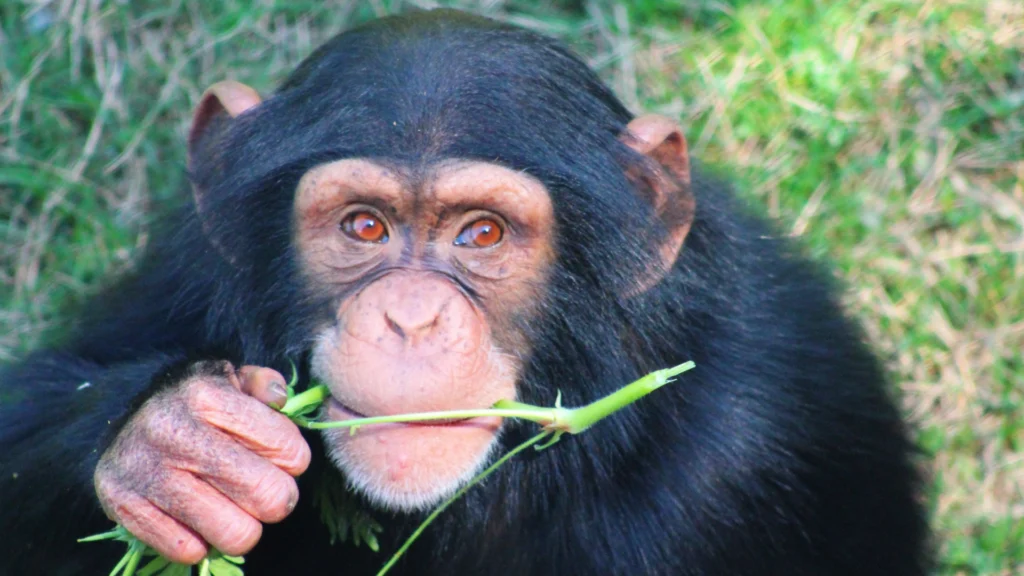
A chimp’s diet consists of about 300 different items – 60 per cent fruits, 20 per cent leaves, and about 10 per cent seeds and blossoms. The small remaining percentage is made up of insects and the occasional bit of meat (less than two per cent). Their favourite food is ripe fruit and berries.9https://www.wildchimps.org/about-chimpanzees/what-they-eat.html
Chimpanzees have complex social groups
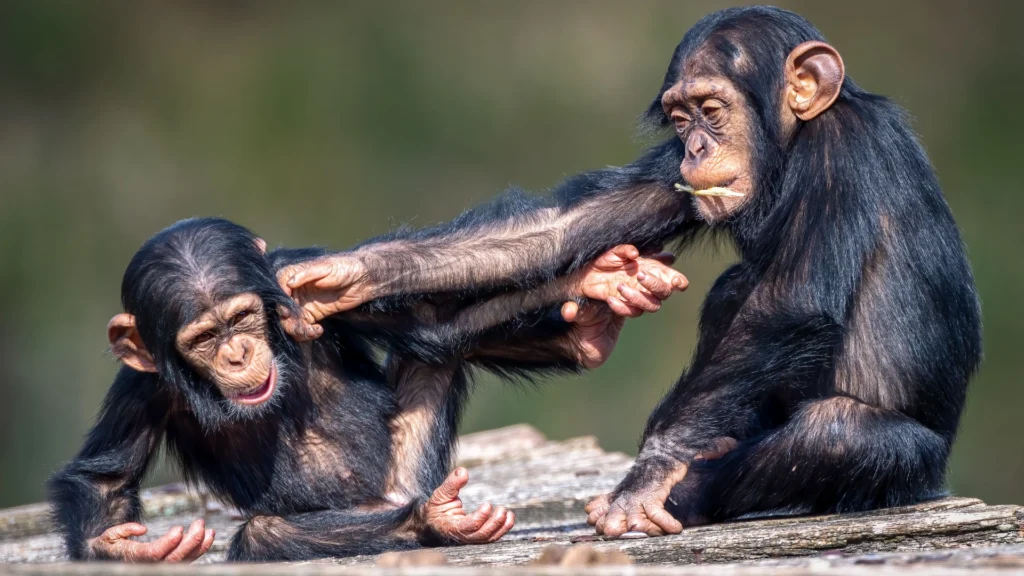
Chimps live in hierarchical groups (called communities or troops) of between 12 and 150 individuals and the stability of the group depends on good relationships between the males. At the top of the hierarchy is the alpha-male: he’s the strongest chimpanzee and may also have many friends who help him stay in power. There is also an alpha-female at the head of the female chimpanzees. Her position isn’t based on brute strength but through good relationships and personality.10https://news.janegoodall.org/2018/07/10/top-bottom-chimpanzee-social-hierarchy-amazing/ The group splits into smaller parties to forage during the day. The alpha male keeps in touch with the smaller groups by drumming on the buttress roots of certain trees. That way all the chimps know where the males are and where to meet to build their sleeping nests.11https://www.wildchimps.org/about-chimpanzees/how-they-live.html
Should I stay or should I go?
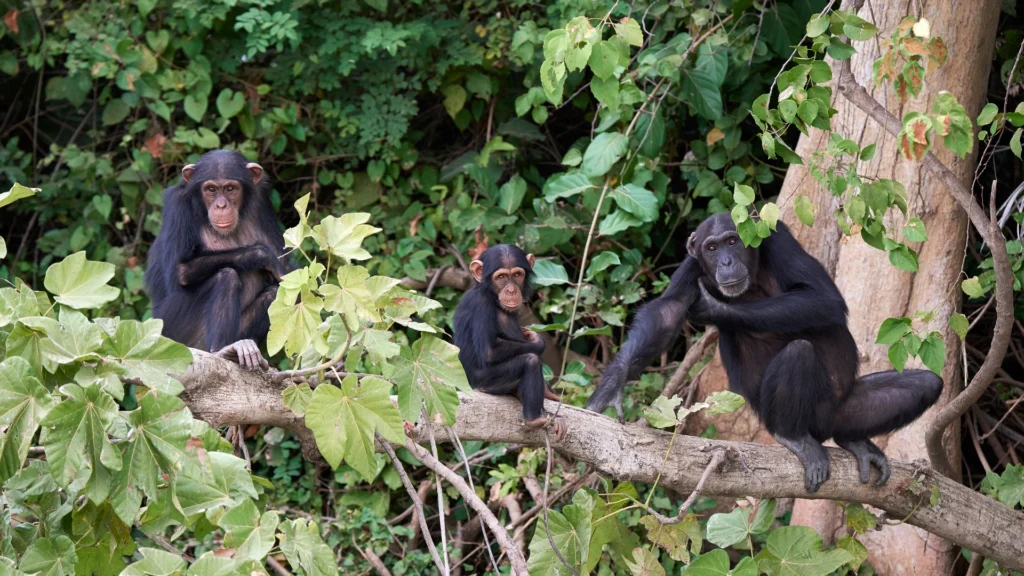
Males stay in the same group for life. For females it is a different story. Just before they become sexually active, they head off to a community of strangers. They never see their family again. In contrast, a mother is usually close to her sons for their entire life.12https://www.psychologytoday.com/gb/blog/wild-cousins/202212/the-mystery-of-why-female-chimps-leave-their-groups
Chimps are promiscuous
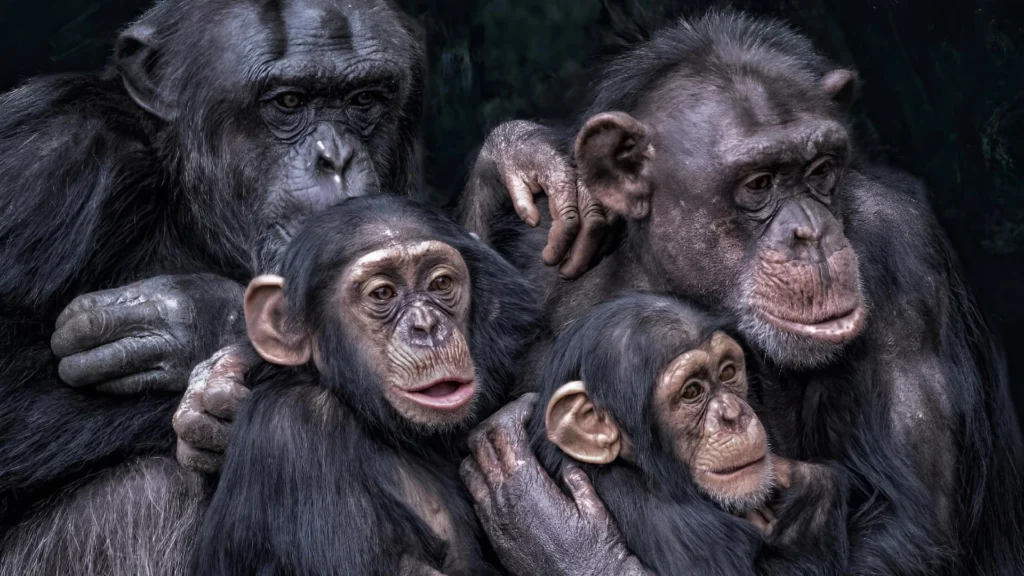
When a female is fertile, she has sex with several males, and males regularly mate with many different females. This means that no one knows who their father is, and fathers do not know their daughters. The chimps solve the problem of incest and maintaining a healthy genetic pool by the females leaving the group just before puberty.12https://www.psychologytoday.com/gb/blog/wild-cousins/202212/the-mystery-of-why-female-chimps-leave-their-groups
Chimpanzees have clever ways to communicate
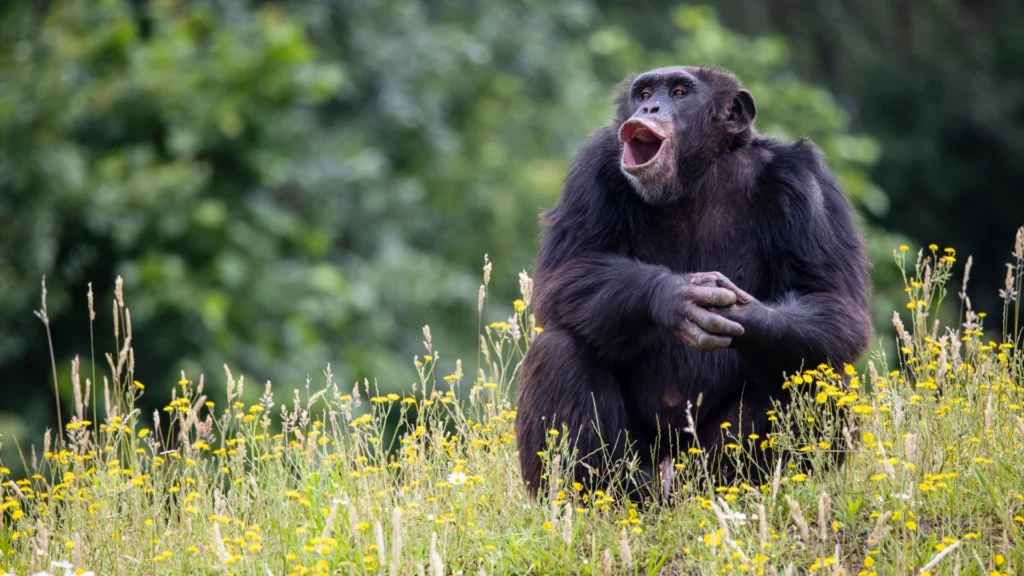
Chimpanzees use sounds and gestures to communicate. Researchers recorded over 2,000 different gestures used by a group of chimpanzees in Uganda’s Budongo Forest Reserve and they found that chimpanzee language has some of the same rules as ours. For example, the most commonly used gestures are short just like our most commonly used words.13https://phys.org/news/2019-02-chimp-gestures-human-linguistics.html
Chimpanzees love being pampered
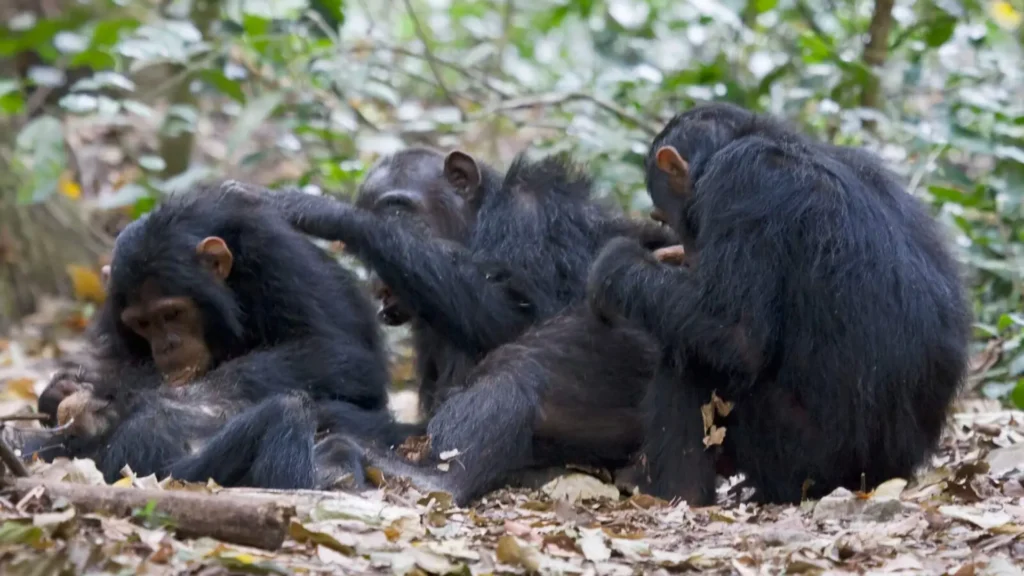
Chimps spend a lot of time grooming their family and friends. They run their fingers through each other’s fur picking out dirt, dead skin and little fleas and parasites. Not only does this keep them clean and looking smart, but it also builds and strengthens friendships.
Chimpanzees are trend setters
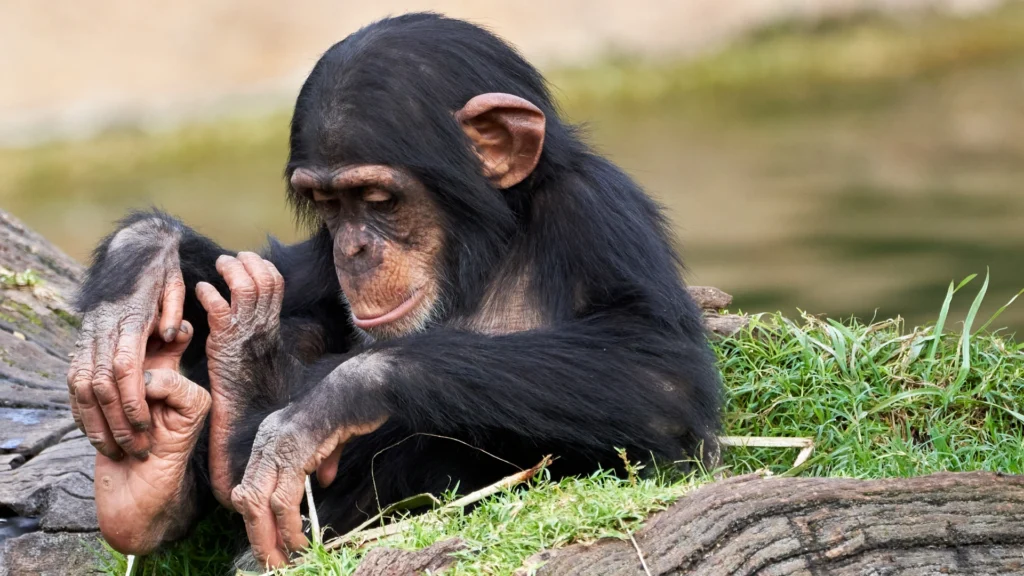
It’s not just humans who sometimes fall victim to silly trends. Back in 2010, a chimpanzee called Julie was seen putting a stalk of grass in her ear, like a fashion accessory. The other chimps in her group must have been impressed because they all copied her!14https://www.treehugger.com/things-we-learned-about-chimpanzees-4864053
Chimpanzees love a fresh bed!
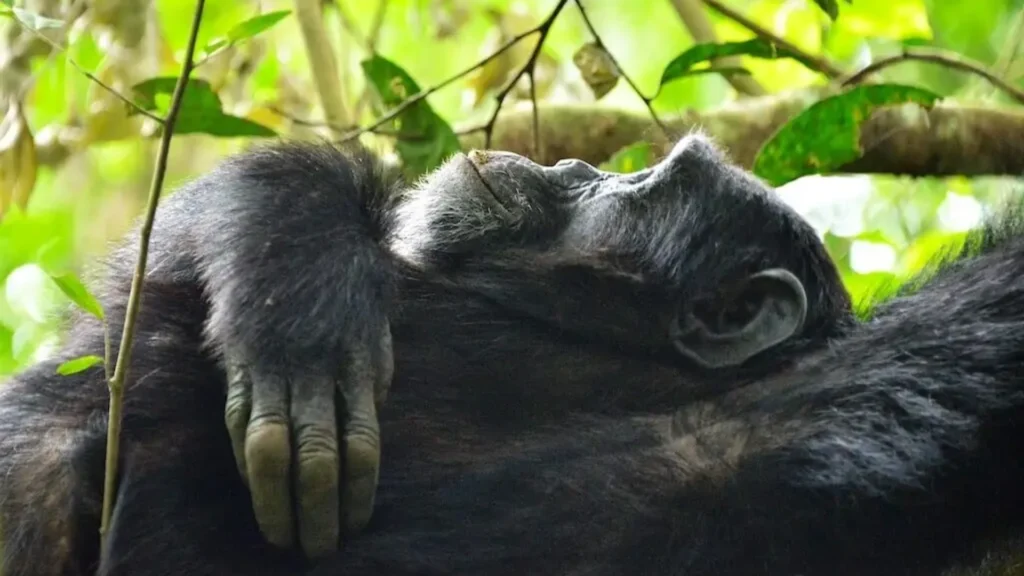
Chimpanzees spend about 12 hours a night sleeping in their nest in the trees, safe from predators. They also take a midday nap before becoming most active in the late afternoon.
Every night chimpanzees build a new nest to sleep in by weaving branches together and making a mattress of leaves. They never sleep in the same bed twice. Scientists have found that chimpanzees share their beds with a diverse range of ‘good’ bacteria whereas humans’ beds often contain more harmful bacteria from our hair, skin and faecal matter.15https://royalsocietypublishing.org/doi/10.1098/rsos.180382
Chimpanzees might have rituals
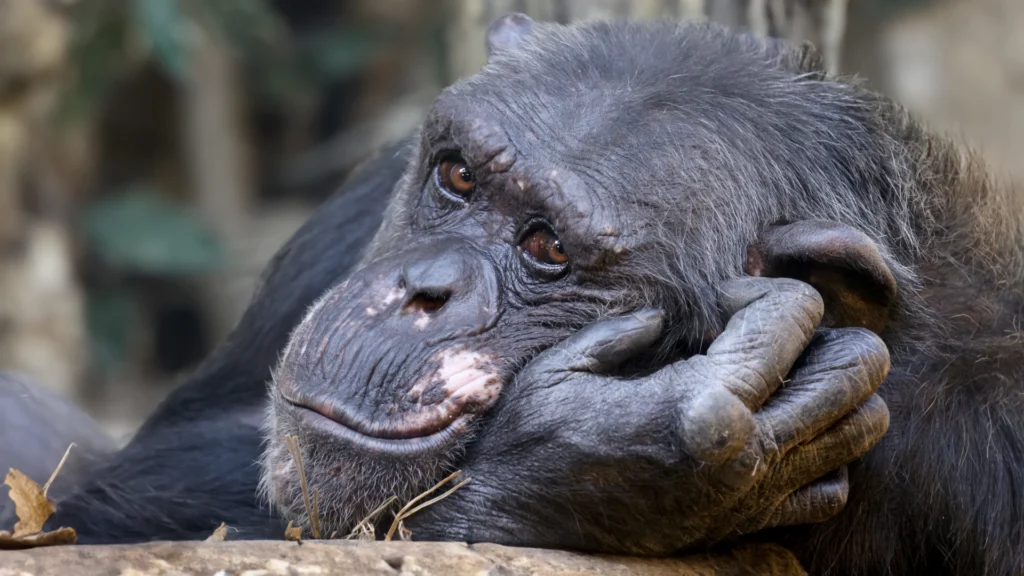
Scientists have filmed chimpanzees picking up stones, making a hooting noise and then throwing the stone at trees with hollow trunks to fill them with rocks. The chimps then hoot again and drum on the ground. The scientists think this could be some kind of chimpanzee ritual or tradition.16https://www.nature.com/articles/srep22219#Sec5
Chimpanzees use nature in ingenious ways
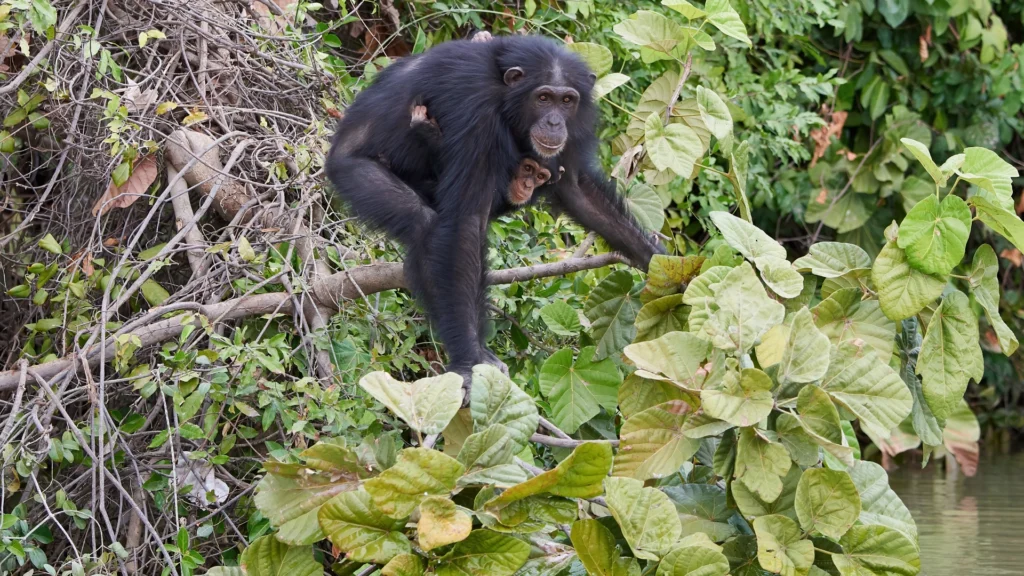
They use grass stalks and twigs like cutlery to pick up termites and ants without getting bitten. They use rocks like hammers to crack open nuts, and they use large leaves for umbrellas when it rains. They might not have smart phones but they have very smart ways of using their natural habitat.
Chimpanzees use natural medicines
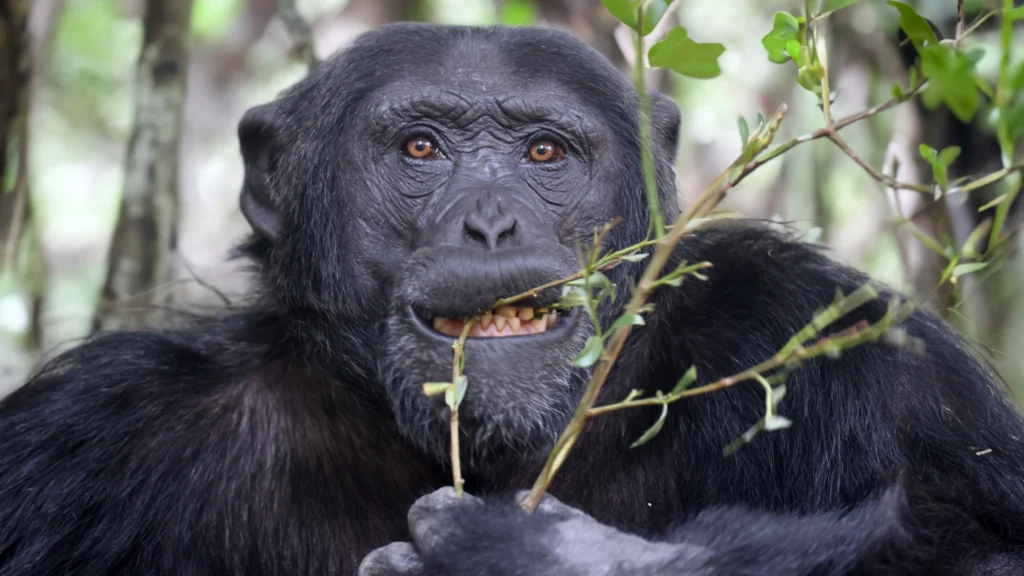
Chimps and other apes have been studied eating plants that are not normally part of their diet to treat parasites and heal wounds.17https://www.pnas.org/doi/10.1073/pnas.1419966111 They have also been seen rubbing insects into wounds and scientists think this is for medicinal purposes too.18https://www.cell.com/current-biology/fulltext/S0960-9822(21)01732-2? This demonstrates are very deep understanding of their habitat and that chimpanzees are capable of passing knowledge through the generations.
Threats to chimpanzees
Habitat loss

As a result of Uganda’s population growth, increased urbanisation, and an increased income for wealthier Ugandans, the demand for animal products is likely to dramatically rise in the coming years. The FAO estimates that by 2050, the demand for meat and milk products in Uganda will more than double and “the production of all types of meat and that of milk will increase by 164 and 41 per cent, respectively.”19https://www.fao.org/3/ca7009en/CA7009EN.pdf
To produce these animal products, land that was once beautiful and iconic savannah and forest – and a home to Uganda’s majestic wildlife – is being turned into farmland. The conversion of land to agriculture is stripping the wildlife of its natural habitat and putting increasing pressure upon the land to support life. In the last 100 years, Uganda has lost 42 per cent of its forest cover, decreasing from 54 per cent to 12 per cent in 2017.20https://illuminem.com/illuminemvoices/deforestation-in-uganda-causes-and-recommendations Encroachment into Queen Elizabeth National Park by illegal cattle ranchers is common21https://conbio.onlinelibrary.wiley.com/doi/abs/10.1111/cobi.12538?campaign=woletoc and the National State of the Environment Report for Uganda 2014, attributes this to “the increasing demand of land for agriculture and fuel wood by the rapidly increasing population growth.”22https://nema.go.ug/sites/all/themes/nema/docs/FINAL%20NSOER%202014.pdf
Of course, a growing population needs food but it would be much more sustainable to meet these needs through the growing of crops instead of farming animals. Animal foods require by far the most land and resources – this is because land is not only used for grazing but also for growing food for the animals. The more animal-based foods we eat, the more endangered our forests become. However, crops are a far more efficient way to feed the growing population and use less land and other natural resources. A vegan diet is associated with only half the cropland demand, grazing intensity and overall biomass harvest of meat-based diets23https://www.nature.com/articles/ncomms11382 so switching to a vegan diet would have a phenomenal impact on reducing deforestation and land degradation in Uganda.
Human-wildlife conflict
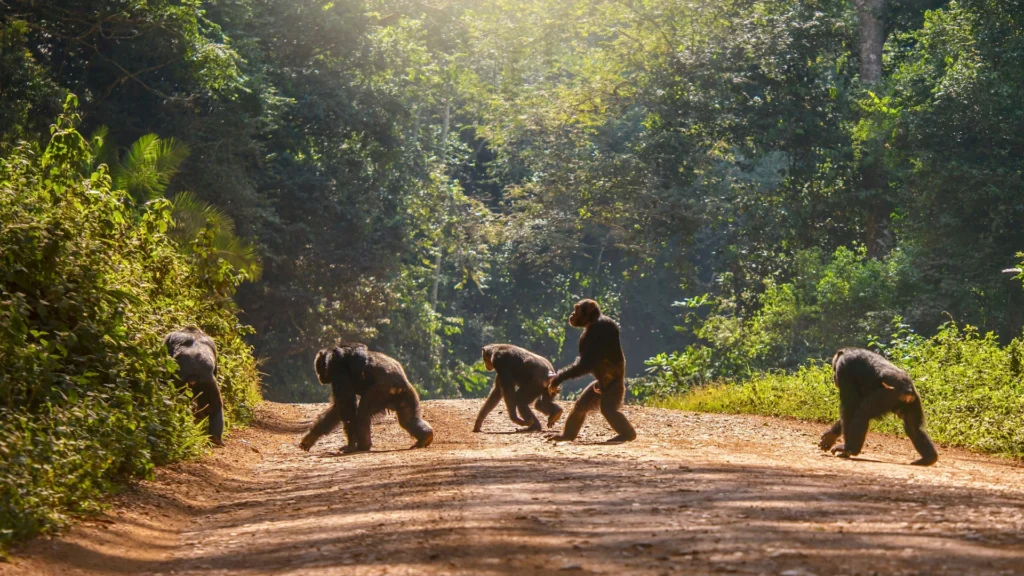
Habitat loss is leading to violent conflicts between chimpanzees and humans. In a village in western Uganda called Kyamajaka, the forests that once sustained the chimpanzees have been totally destroyed leaving the chimps no other option but to raid the crops that now grow where the forest once stood.24https://www.nationalgeographic.com/animals/article/chimps-and-people-are-clashing-in-rural-uganda-feature So desperate for food, the chimpanzees clash with villagers on a small number of occasions – but this can be serious as chimpanzees are strong animals. None of this is done out of maliciousness but as a last resort as their habitat is destroyed. The chimps know that if they want to survive, they have to take desperate measures. The only way to avoid such conflict is for us to respect and preserve the chimpanzees’ environment and for the local people to have ways to support themselves, such as community tourism, that do not rely on destroying or exploiting the forests in which the chimpanzees live.
Disease
Because humans and chimpanzees are so genetically similar, human illnesses can easily spread to chimpanzees. Unfortunately, unlike us, chimpanzees don’t have immunity to many of our illnesses so a common cold could be deadly to them. In fact, in 2013, a common cold infected 56 chimps in Uganda’s Kibale National Park sadly killing five of them.14https://www.treehugger.com/things-we-learned-about-chimpanzees-4864053 The more that humans encroach into the chimpanzee’s territory and the more the chimpanzees are forced to stray into ours, the more likely they are to catch deadly illnesses.
Hunting
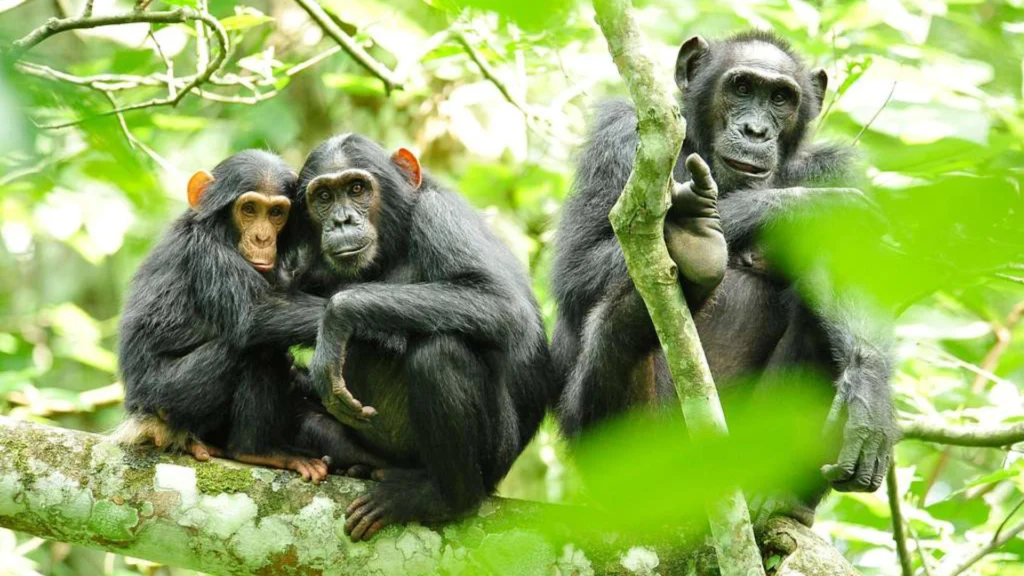
Hunting wildlife for bushmeat is common across all of Africa, and Uganda is no exception.25https://www.ncbi.nlm.nih.gov/pmc/articles/PMC7521682/ Even though the cruel practice is illegal, the laws are ignored and barely enforced. The killing of apes, including chimpanzees, for food is part of the culture in Central and Western Africa but it doesn’t have the same tradition in Uganda. However, there is an emerging problem in Uganda. Other primates are certainly being killed for bushmeat and chimpanzees could also be at risk.26https://learningenglish.voanews.com/a/health-and-environment-concerns-as-ugandans-start-to-eat-primates/1565444.html In fact, a 2020 investigation reported that hunters often disguise primate meat as another kind of meat in markets so people don’t know what they’re buying.25https://www.ncbi.nlm.nih.gov/pmc/articles/PMC7521682/
Eating wildlife isn’t just deadly for the animals, but poses a serious health risk to humans too.26https://learningenglish.voanews.com/a/health-and-environment-concerns-as-ugandans-start-to-eat-primates/1565444.html Chimpanzees, monkeys and other animals can carry Ebola – a deadly virus that can be caught by eating an infected animal or coming into close contact with someone who already has it. In 2007, there was an Ebola outbreak in the Ugandan town of Bundibugyo and it was confirmed that the victims had either eaten or butchered infected primates.
In Uganda’s National Parks and Forest Reserves, chimpanzees are rarely hunted for food thanks to the dedicated protection of the park rangers. Instead, the threat comes from snares used to illegally hunt other animals. The snares are indiscriminate killers and many chimpanzees fall victim to their cruel grip. Horrifyingly, around 20 per cent of individuals in Budongo Forest and Kibale National Park have been maimed in some way by snares, and across Uganda one-third of all chimpanzees have some kind of deformity caused by a snare.27https://ugandawildlife.org/animals/chimpanzee/ Park rangers constantly sweep the forest dismantling any snares they find. In Uganda’s Kibale National Park, the number of chimps killed in snares has gone down from one every nine months to one every 15 months thanks to the rangers’ patrols.28https://news.mongabay.com/2020/10/in-uganda-safeguarding-chimpanzees-against-the-scourge-of-snaring/
References
References
- 1
- 2
- 3
- 4
- 5
- 6
- 7
- 8
- 9
- 10
- 11
- 12
- 13
- 14
- 15
- 16
- 17
- 18
- 19
- 20
- 21
- 22
- 23
- 24
- 25
- 26
- 27
- 28

